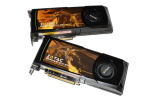3. Metodologia di test
Configurazione di prova
Per valutare le prestazioni delle schede video di ultima generazione, abbiamo assemblato un sistema particolarmente potente dotato di CPU Core i7 920, preventivamente overcloccato a 4 GHz, 6 GB di Ram Corsair Dominator e di un alimentatore Corsair HX1000.
Â
| Processore | Intel Core i7 920 @ 4 GHz (200*20) |
| Scheda Madre | Gigabyte X58 Extreme |
| Memoria RAM | 3*2 GB Corsair Dominator TR3X6G1600C7D |
| Hard Disk | Corsair Force Series CSSD-F60GB2 Western Digital VelociRaptor 150 GB |
| Alimentatore | Corsair HX1000 |
| Sistema Operativo | Microsoft Windows 7 Ultimate 64 bit |
| Monitor | Samsung SyncMaster 2443BW |
Â
Ai fini comparativi abbiamo incluso nei grafici le seguenti schede video:
Â
| Schede Video NVIDIA | Schede Video ATI |
| SLI NVIDIA GeForce GTX 570 1280 MB NVIDIA GeForce GTX 580 1536 MB NVIDIA GeForce GTX 570 1280 MB | CFX AMD Radeon HD 6970 2 GB ATI Radeon HD 5970 2 GB AMD Radeon HD 6970 2 GB AMD Radeon HD 6950 2 GB |
Â
Â
Driver utilizzati
Driver NVIDIA: GeForce 263.09 WHQL
Driver AMD: AMD Catalyst 10.12
Â
Batteria di test
Tutti i giochi sono stati testati alle risoluzioni 1280x1024, 1680x1050, 1920x1200 con le impostazioni di seguito riportate:
- Futuremark 3DMark Vantage â DX10 â Profili Performance, High ed Extreme
- Futuremark 3DMark 11 - DX11 - Profili Performance ed Extreme
- Unigine Heaven BenchMark 2.1Â â DX11Â â Tessellation Normal
- The Last Remnant â DX9.0c
- Call of Duty 4: Modern Warfare â DX9.0c â Qualità Massima AA4x
- FarCry 2 â DX10 â Qualità Massima AA4x
- Crysis â DX10 â Qualità Massima NOAA e AA4x
- Crysis WarHead â DX10 â Qualità Massima NOAA e AA4x
- Mafia 2 â DX10 â Qualità Massima AA4x
- Metro 2033 â DX11 â Qualità High
- Lost Planet 2 â DX11 â Qualità Massima No AA, Test A
Â
Â









